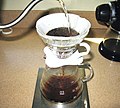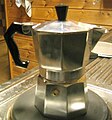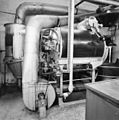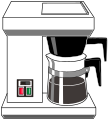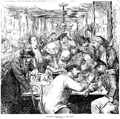Portal:Coffee
The Coffee Portal
Coffee | Drinks | Coffeehouses | Companies | Culture | Preparation | Production
Introduction
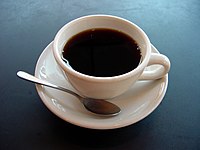
Coffee is a beverage brewed from roasted coffee beans. Darkly colored, bitter, and slightly acidic, coffee has a stimulating effect on humans, primarily due to its caffeine content. It has the highest sales in the world market for hot drinks.
The seeds of the Coffea plant's fruits are separated to produce unroasted green coffee beans. The beans are roasted and then ground into fine particles typically steeped in hot water before being filtered out, producing a cup of coffee. It is usually served hot, although chilled or iced coffee is common. Coffee can be prepared and presented in a variety of ways (e.g., espresso, French press, caffè latte, or already-brewed canned coffee). Sugar, sugar substitutes, milk, and cream are often added to mask the bitter taste or enhance the flavor.
Though coffee is now a global commodity, it has a long history tied closely to food traditions around the Red Sea. The earliest credible evidence of coffee drinking as the modern beverage appears in modern-day Yemen in southern Arabia in the middle of the 15th century in Sufi shrines, where coffee seeds were first roasted and brewed in a manner similar to how it is now prepared for drinking. The coffee beans were procured by the Yemenis from the Ethiopian Highlands via coastal Somali intermediaries, and cultivated in Yemen. By the 16th century, the drink had reached the rest of the Middle East and North Africa, later spreading to Europe. (Full article...)
Selected article -

Home roasting is the process of roasting coffee from green coffee beans on a small scale for personal consumption. Home roasting of coffee has been practiced for centuries, using simple methods such as roasting in cast-iron skillets over a wood fire and hand-turning small steel drums on a kitchen stovetop.
Until the early 20th century, it was more common to roast coffee at home than to buy pre-roasted coffee. Following World War I, commercial coffee roasting became prevalent, and, combined with the distribution of instant coffee, home roasting decreased substantially.
In recent years, there has been a revival in home roasting. What was originally a necessity has now become a hobby. The attractions are four-fold: enjoying fresh, flavorful coffee; experimenting with various beans and roasting methods; perfecting the roasting process, and saving money. Other factors that have contributed to the renewed interest in home roasting coffee include coffee suppliers selling green coffee in small quantities and manufacturers making counter-top roasters. (Full article...)General images -
More did you know? -
Selected drink -
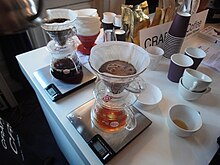
Selected image -

Did you know (auto-generated)

- ... that Arab Coffeehouse depicts Henri Matisse's visit to Tangier, where he saw its locals gaze for hours into fishbowls?
- ... that actor Tatsunari Kimura ate pancakes and drank coffee while talking for eight hours during the filming of the television drama Old-Fashioned Cupcake?
- ... that Kenyan coffee farmer "Pinkie" Jackson amassed Africa's largest collection of native butterflies?
- ... that Monmouth Coffee Company in Covent Garden was one of the foundations for the third wave of coffee in London?
- ... that Justly Watson died suddenly in 1757 from the effects of poison administered in his coffee, it was believed, by a servant?
- ... that Bob Dylan poked Emmylou Harris when he wanted her to start singing during the recording of "One More Cup of Coffee (Valley Below)"?
- ... that the city council of Bandung in the Dutch East Indies initially met at the site of a former coffee-packing factory?
- ... that the short story collection Drinking Coffee Elsewhere was chosen by John Updike as a selection for the Today Show book club on NBC?
Topics
Categories
Related portals
Related WikiProjects
- WikiProject Agriculture
- WikiProject Beer
- WikiProject Food and Drink
- WikiProject Spirits (semi-active)
- Wikiproject Wine (semi-active)
- WikiProject Bartending (Inactive)
- WikiProject Breakfast (inactive)
- Wikiproject Bacon (inactive)
Associated Wikimedia
The following Wikimedia Foundation sister projects provide more on this subject:
-
Commons
Free media repository -
Wikibooks
Free textbooks and manuals -
Wikidata
Free knowledge base -
Wikinews
Free-content news -
Wikiquote
Collection of quotations -
Wikisource
Free-content library -
Wikispecies
Directory of species -
Wikiversity
Free learning tools -
Wiktionary
Dictionary and thesaurus
Web resources

- World Coffee Research – a 501 (c)(5) nonprofit program of the international coffee industry. (Wikipedia article: World Coffee Research)
- Coffee Research Foundation – based in Kenya, and founded in 1908
- Central Coffee Research Institute – based in Chickmagalur District, India, and founded in 1915



